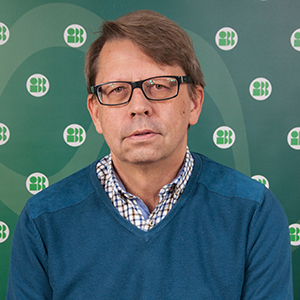Laboratory of Plant Pathogenesis
Prof. Jacek Hennig, PhD, DSc
Laboratory of Plant Pathogenesis
ORCID: 0000-0003-0156-1320
Research Scope
Main Scientific Achievements
- We found that the TNL immune receptor Rysto recognizes the PVY coat protein and is required for PVY-triggered immunity. The expression of Rysto confers an extreme resistance response in potato that stops viral replication without triggering cell death.
- We used high-throughput phenotyping and gene expression analyses to search for relationships between morpho-physiological and molecular responses to water deficits.
Research Description
In response to pathogen infection, plant cells initiate a signaling cascade that leads to changes in expression profiles of many genes and consequently the reprogramming of cellular metabolism. To establish a successful defense strategy, this response must occur quickly and effectively. Therefore, the recognition of pathogen-derived signals appears to be a critical process.
The aim of our laboratory is to reveal critical components of plant defense signaling networks using cutting-edge approaches in molecular biology and biochemistry. The availability of potato genotypes that differ in their response to PVY is a good basis to identify their resistance sources. Classic approaches, even assisted by data that were acquired from the Potato Genome Sequencing Consortium, did not result in expanding a list of agriculturally suitable DNA sequences.
A useful technique that combines target enrichment (TE) and next-generation sequencing (NGS) was developed to accelerate the cloning of genes from large eukaryotic genomes. We applied this technique to isolate and characterize the Rysto gene that is responsible for the recognition of PVY upon infection that in turn initiates the activation of a pathway that leads to extreme resistance. In parallel to this high-throughput molecular approach, we identified PVY coat protein (CP) as an avirulence factor in Rysto-triggered immunity. To precisely map a minimal CP fragment that is sensed by Rysto,, we created a series of constructs that encode truncated CP variants. We found that any deletion that affected the CP core abolished virus perception, indicating that an intact CP core was required for the Rysto-dependent resistant response. In the future, we would like to concentrate on elucidating the mechanisms of CP recognition by Rysto. We will also focus on the nature of effectors that are involved in direct or indirect Rysto-CP interactions.
Additionally, we developed a biological system to provide new insights into the extreme resistance type of defense. It is extremely important to assess whether the introduction of Rysto as a single element into other potato varieties or into different plant species (e.g., tomato, tobacco, eggplant) activates entire signaling cascades that lead to the establishment of extreme resistance.
In parallel to the main scientific interests of our laboratory, we also developed two small projects. In the first project, we applied high-throughput phenotyping and gene expression analyses to search for relationships between morpho-physiological and molecular responses of plants to water deficits. The second project focused on the characterization of a novel calcium binding protein that is involved in pollen development, with a special emphasis on its role in ribosomal RNA metabolism.
Selected Publications
- Baebler Š†., Witek K†., Petek, K. Stare K., Tušek-Žnidarič M. Pompe-Novak M., Renaut J., Szajko K., Strzelczyk-Żyta D., Marczewski W., Morgiewicz K., Gruden K. and Hennig J*. (2013) Salicylic acid is an indispensable component of the Ny-1 resistance-gene-mediated response against Potato virus Y infection in potato. J. Exp. Bot. (2014) 65(4): 1095-1109 doi: 10.1093/jxb/ert447.
- Rymaszewski W., Vile D., Bediee A., Dauzat M., Luchaire N., Kamrowska D., Granier Ch. and Hennig J*. (2017) Stress-Related Gene Expression Reflects Morphophysiological Responses to Water Deficit. Plant Physiol. 174 (3): 1913-1930 doi: 10.1104/pp.17.00318.
- Grech-Baran M., Witek K., Szajko K., Witek A., Morgiewicz K., Wasilewicz-Flis I., Jakuczun H., Marczewski W., Jones J.D.G. and Hennig J*. (2020) Extreme resistance to Potato Virus Y in potato carrying the Rysto gene is mediated by a TIR-NLR immune receptor. Plant Biotech. J. 18(3): 655-667 doi: 1111/pbi.13230.


